Peter Canning: Unifying Light
Posted on May 24, 2017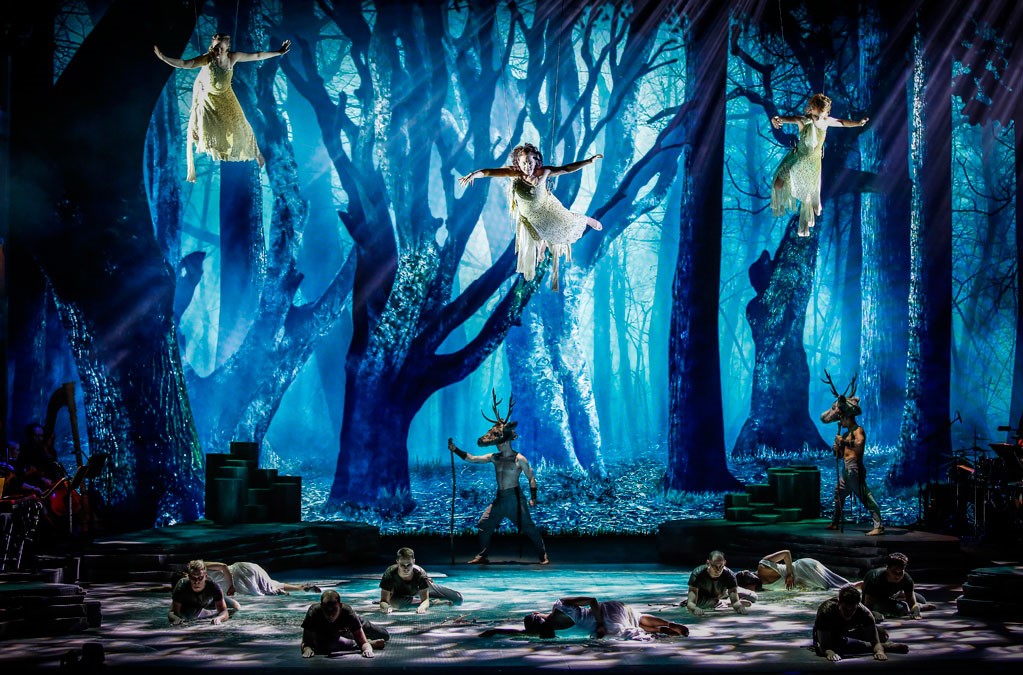
Photo: RTÉ
Visionary….the word that came up quite often when we told other lighting designers that we would be interviewing Peter Canning. The Prime Time Emmy Award winning Dublin-based designer has earned the widespread admiration of his peers for bravely pushing ahead into new technologies and incorporating them into groundbreaking designs. While many others were gingerly testing the waters of concepts like projection video mapping and 3D visualization, Canning was plunging into these technologies headlong — and most often resurfacing with visually stunning results.
For all his formidable technical skills, however, Canning remains firmly in touch with the human heart of lighting design. When asked to list the most indispensable tools an LD can have, he quickly cited the collaborative efforts of other people. Drawing on his own considerable talents as well as the input from colleagues, Canning has amassed an impressive, and quite eclectic, body of work. His portfolio includes television (he has been the LD for The Voice of Ireland for several seasons and is currently the designer for the Irish version of Dancing With The Stars), events like Riverdance, concerts, theater, and building projections like the acclaimed “The Urban Voices” and Dublin’s famous “Simon House of Light.”
In addition to running his own company, High Res Lighting Design, Canning is also an associate lighting designer at Al Gurdon’s Incandescent Design. It was in this capacity that he shared a Prime Time Emmy Award with Gurdon for their work at the Sochi 2014 Winter Olympic Games. Taking time from his busy schedule, the Irish LD spoke to us about unifying technology and art into harmonious lighting designs.
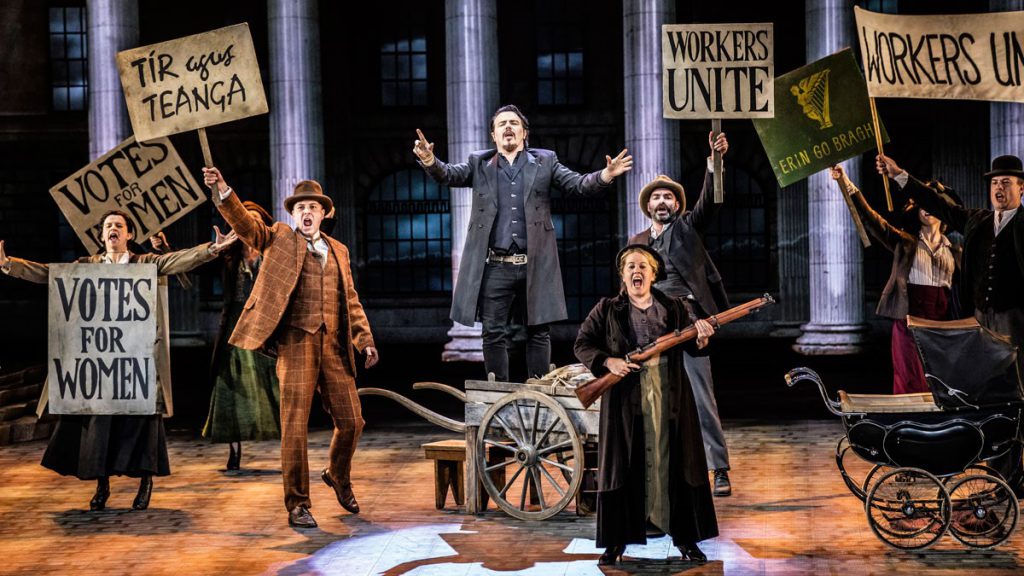
Photo: RTÉ
You’ve also been at the forefront in the convergence of lighting and video technology. Do you draw a distinction between what is “lighting design” and what is “video design?”
“I think that the distinction between the two is purely technical, as creatively they both aim for a similar result of augmenting moods or creating scenes. It’s a bit like an orchestra — there are lots of different types of instruments of varying sizes and sounds, but they are all playing the same musical score and work together to produce a single work.”
So if it is like an orchestra, what advice would you give on harmonizing the lighting and video aspects of a design?
“I’m a big believer in the single picture approach to broadcast lighting design. As a lighting designer you need to think of all the elements which make up a picture on a screen and how they each augment the mood or setting that you are trying to create. Lighting and video need to work together to create a balanced image with one not overpowering the other, but this is also true of all other creative elements such as staging, costume, styling, pyro and special effects. When all elements augment to create a single coordinated image, it results in a powerful, stunning visual. If video projection is involved in the project, it’s advisable to find the maximum light level that this projection will be working to and base your lighting lux level calculations on this, as it will be your Achilles Heel!”
Another thing you’re widely known and respected for is being an early adapter of 3D visualization. What drew you so early on to this design process?
“A picture is better than 1,000 words! I started using visualizations as a tool that allowed me to present and understand the value of allocating budgets to specific design ideas and concepts. It also helped me design ideas that might otherwise have been more difficult. I now use 3D visualizations for the design and programming stages of the design process. I find good renders or visualizations make it very easy to discuss design ideas with producers and other creative people. I also find them essential when discussing budgets.”
Now that you’re experienced in 3D visualization, has it lived up to your expectations?
“It has in some aspects, but I think there is still a lot of work to be undertaken between the visualization software and technical drawing process when you’re dealing with design workflows that may involve many different departments or indeed a central CAD team. Most of the 3D visualization software systems don’t easily interact with the same workflow that a program like AutoCAD uses. Therefore it’s difficult to have input from multiple departments. Nearly all of the shows that I have undertaken recently have the main lighting or video plans drawn in a CAD based program and only turned into a 3D visualization program such as WYSIWYG at the end of the process.”
What programming tools do you like to use when designing?
“I use AutoCAD and Vectorworks for drawing and WYSIWYG for visualizations. I came from a programming background but I’ve found over the last number of years that I use programming software or lighting consoles less and less, mainly because I see the role of a programmer on a lighting team as a hugely important, independent position. I rarely program or operate my own shows now, so I tend to just use the basic control tools in WYSIWYG design to look at how lighting fixtures will work in the environment they are set in. I normally ask for WYSIWYG sessions to be allowed for in the show budget. Once the lighting team is put together and the programmers are appointed, we will all look at the design in WYSIWYG with the lighting programmers using the lighting consoles that they have requested. I find that the first few days of this type of session will usually reveal any potential issues or conflicts in the design. This is hugely beneficial because you may not have seen or anticipated those issues earlier in the process.”
Setting technology aside for a moment, it still always starts with an idea inside one’s head. So how do you get inspired at the very start of a project? What gets your creative juices flowing?
“I really enjoy working as part of a design team particularly as each project introduces you to new people and thus new approaches and ideas. That inspires me! The role of a lighting designer is to create atmospheres and moods which augment a show’s creative dimensions. I really enjoy the very first meeting of the creative team when we listen to the initial overview or presentation.
“In my opinion, the best producers and creative directors have a clear vision of the story a show needs to tell, but at the same time, they leave room for the creative team to add its own input to the overall concept. I really enjoy the lateral thinking that goes on during the creative meetings. The suggestions about design approaches; the suggestions on the creative use of technology; the constructive criticism; and the problem solving, all come together to produce a single creative concept. This is a process I find quite exhilarating.”
So you can take criticism?
“I really enjoy listening to other peoples’ views and contributing ideas and suggestions and I do like criticism….providing it’s constructive!”
Do you ever totally scrap a design and start over?
“I’ve never totally scrapped a design, but I have completely changed elements of it based on either how a concept has evolved or if there is a major change in the production design.”
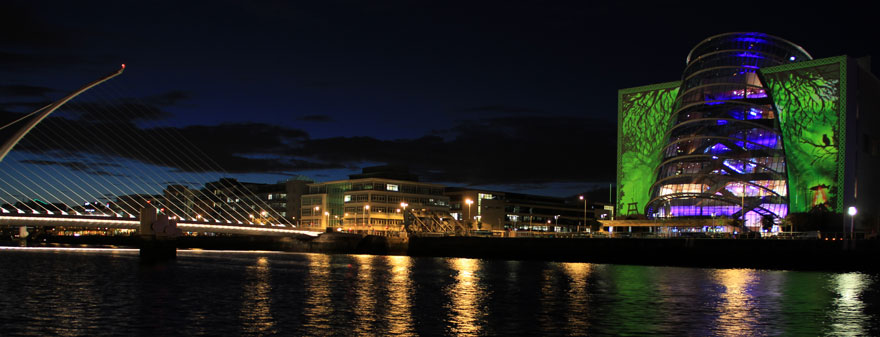
Photo: High Res Lighting
You live in one of the most beautiful countries on earth. Does being in Ireland influence your design process?
“I love living in Ireland, as it’s a very relaxed lifestyle surrounded in rich heritage, and even though it’s a relatively small country on the western edge of Europe, it is very diverse. Being in Ireland does have its geographical drawbacks, as I’m not located at the center of large show productions like LA or London. However, I’ve undertaken projects here that have involved lighting or projecting on buildings or sites rich in historical and mythological stories. The Celtic calendar, Megalithic Passage Tombs like Newgrange and Christian Heritage sites all over the country have light at their core — and these create amazing references for light and shadow, which can inspire creativity!”
Why did you become a lighting designer? You went to Ravensbourne, which is of course renowned for its broadcast arts.
“My father was a TV director and I remember as a kid going into studio with him and watching lots of different types of shows, which he was directing, but I was always fascinated by the lighting department. I went to school in Blackrock College in Dublin, which had a very strong drama department and one of the teachers there, Toirleac O’Brien, really supported those of us who had an interest in technical theatre. He gave me a platform to start lighting shows. While visiting one of the lighting hire companies in Dublin, I came across a lighting magazine which had an article on Ravensbourne and I immediately wanted to go there.”
Your New Year’s Eve Projections, “The Urban Voices” and other building projects are very impressive. Can you describe how you approach these projection lighting projects? Are there particular architectural elements of a building that you look at first to set your creative compass?
“Each building art project has a unique creative, which we always relate to. For example the first projection show, which was developed for New Year’s Eve on Trinity College in Dublin, had a creative based on the façade of the building collapsing to reveal a huge Georgian countdown clock. We decided to style the graphics on Steampunk as it fitted well with the architecture and function of the building. We created a story that this clock would only reveal itself once a year – on New Year’s Eve. In the days leading up to the show, we had a custom soundscape of a ticking clock with a cuckoo running as a loop on the façade. This created a teaser campaign for the projection show.
“The approach for this show was very different from ‘The Urban Voices.’ The creative for ‘The Urban Voices’ was based on a customized music track by Irish DJ Mark McCabe that used day in and day out sounds of the city to create a dance music track. We created graphics that coordinated with this track. So in both cases the buildings were surveyed, and graphic masks and models were created to allow the graphic designers to perfectly interact with the architecture of each building. In the end, even though they may appear to be quite different, there is a common creative thread running through both projects.”
What is the biggest challenge involved in lighting buildings?
“I prefer to light or project onto buildings with all of the lighting or projection hardware hidden as this adds to the magic of the visual. Finding locations which are good positions for lighting or projection hardware and allow for the installation of services such as power and data, is the biggest challenge”
Your TV work for the The Voice of Ireland and other programs is very scenic just as your building designs are. Did your experience in TV help you when you got involved in lighting buildings?
“I would say that they augmented each other. In both disciplines you are trying to create depth and perspective from relatively flat surfaces. With buildings you try and create effects such as the building bending, collapsing, 3D bricks falling, all of which are based on perception of shadows or creating a forces perspective. This is also exactly what we try and do with flat LED screens or digital scenery in a TV studio.”
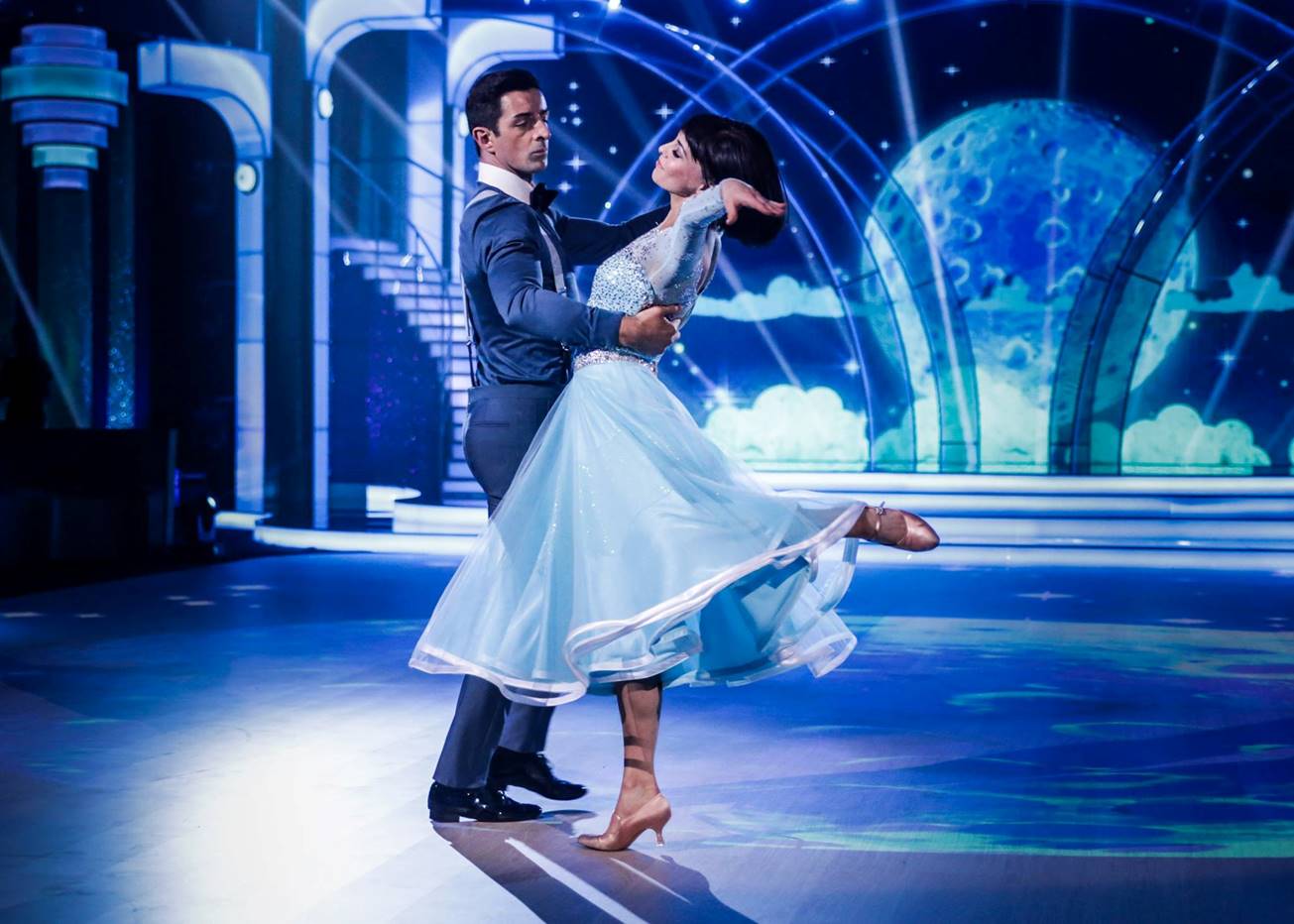
Photo: Dancing With The Stars Ireland
Speaking of TV, what is the secret to collaborating successfully with directors and scenic designers?
“I think you need to be always aware that you are a part of a team and how you interact with that team is key to a successful result. Directors and Production Designers have their own challenges, responsibilities, aims and deadlines and once you respect these then it can be a fantastic process. Directors need to create camera scripts ahead of rehearsals or their camera crew won’t know what’s going on. The best directors that I’ve worked with are open to discuss these with an LD ahead of time or change them when you request a wide shot or suggest a shot during rehearsals. With a project like The Voice or Dancing With The Stars, I work very closely with Fiona Cunningham who is a leading Irish Television Production Designer.”
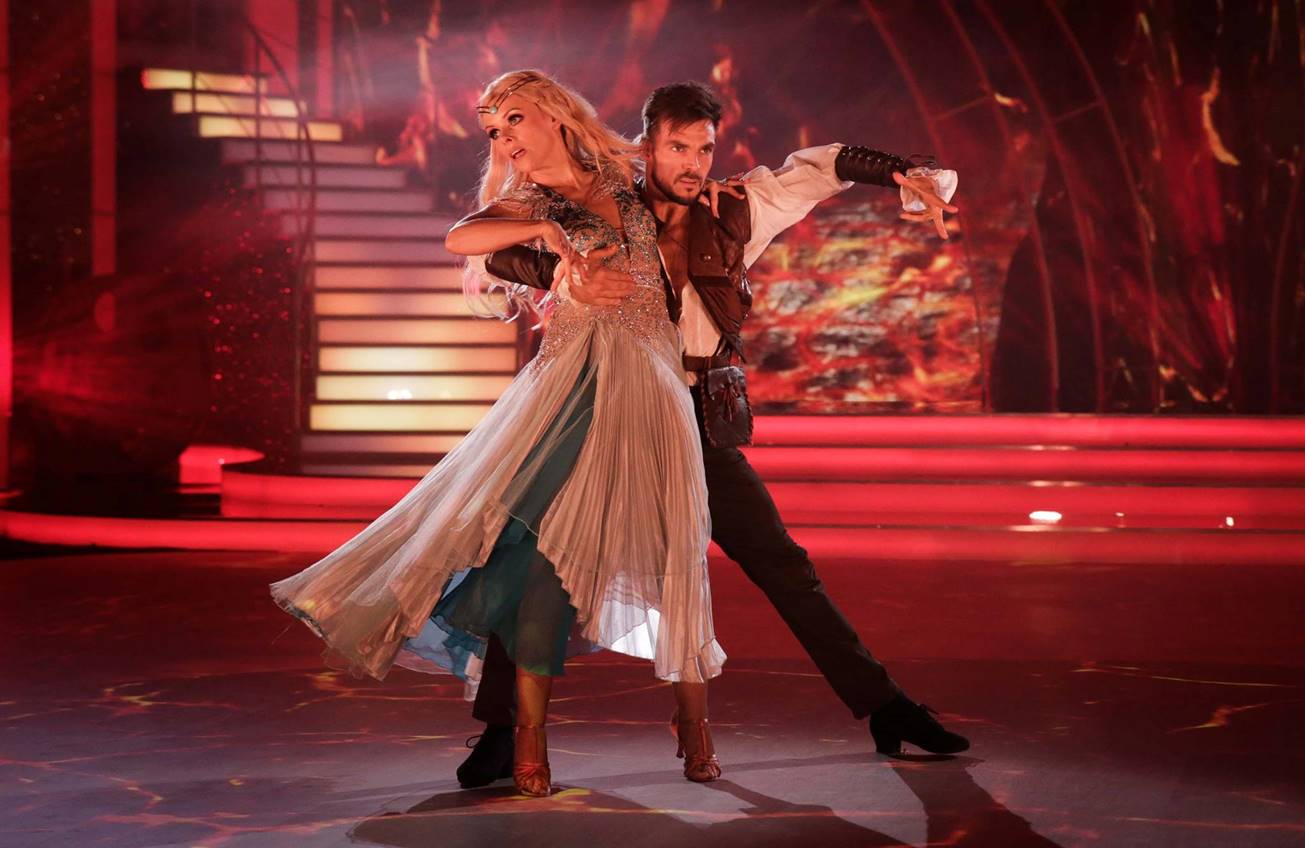
Photo: Dancing With The Stars Ireland
How do you keep all of the effects lighting you do on TV projects from interfering with your key lighting?
“I always start with careful placement of key lighting positions based on a camera plan and set design and then work out the best positions for effects lighting. With most of the LE shows that I do, the key lighting needs to be flexible and I rely on a combination of automated profiles with shutters and follow spots placed at positions which will cover key lighting, creative key lighting and presenter link positions. I place effects lighting around these positions, keeping in mind the production design. However, a good lighting programmer will be able to inhibit or control effects lighting, keeping it off faces, scenery or any other elements which you don’t want it to hit. Keeping good contrast in camera pictures is a priority so I’m always conscious of lighting beams between a subject’s face and a camera — or having too much of the lighting rig switch on, which can create a milky, low contrast look. These are always challenges when you are shooting multi-camera!”
The scenic nature of your work sometimes evokes images of great paintings… Do you have any background or interest in art? Are there any artists from the past who you think would have made great lighting designers if they were around today?
“I have an interest in art, but it tends to go through phases based on the productions we’re working on! For example we recently designed the 1916 Centenary Show for RTE and we used Irish Artists such as John Hinde and Sean Keating as a basis for some of the graphic content. This led me to revisit some of Jack B Yates works since we were focusing on Irish Artists. The use of light in paintings is something that I have huge respect for, especially as I can’t draw or paint. I also have huge respect for the Cinematographer Vittorio Storaro (Oscar winner for Apocalypse Now and The Last Emperor), especially his view on how color affects people, physically and psychologically.”
What in your view are the three or four most valuable tools in a lighting designer’s tool chest today?
“The tools are people and your own talent, more than technology. So I would say lighting programmers with a great attitude and work ethic who don’t rely on effects engines and know why step times are very important. Then there are good experienced Gaffers / Crew bosses who understand how to react and deliver the ever changing requests from the creative department. There’s also the Creative Vision Supervisor who can funnel the creative visual through the technical restrictions of a modern broadcast camera.
“Of course I can’t leave out my ears! I think that a good lighting designer will listen to the expertise within a crew from gaffers to technicians to programmers to vision supervisors, and allow them space to offer suggestions and input to physically deliver the creative vision… It’s up to you to decide which advice offers the best augmentation to the production! From the product perspective, I would say that the most important tools are lights that have been designed to do one job well. I am not a fan of multifunction fixtures. Another important tool is a good three chip color meter for accurate green / magenta balancing, particularly for follow spots.”
Who were the big influencers in your career?
“From a design point of view, Al Gurdon. There has traditionally always been a division between the live and broadcast elements of a show and I was really impressed when I first saw Al’s work as he seemed to be able to bridge this. It’s been great to work as an assistant and associate designer to him for the last number of years and see at first-hand his design approach. I will always remember a short speech he gave at a production meeting in Sochi reminding everyone that where there might be a live audience of 40,000 people in the stadium, there was 2.8billion watching on TV!
“I think Al is one of the only international designers with an approach to lighting design for broadcast, which preserves and augments the show creative for the TV camera. With more shows being broadcast, streamed on the web and shared on social media, a lighting design approach for the electronic eye is more important now than ever before. His understanding of both broadcast and live event lighting techniques is unique and this is something I try and bring to my own work.
“From a design company point of view, Kerrie-Ann & Linda, who are project and account managers in our office and they are the realists in my world. ‘Nothing is a problem, it’s just a cost’ is a line that’s constantly driven into my head and they have both brought a firm business approach to our design studio. Home life is also very tricky to juggle in this industry and I’m lucky to have a very patient wife, Caroline, who puts up with the challenges and changes that this industry is famous for!”